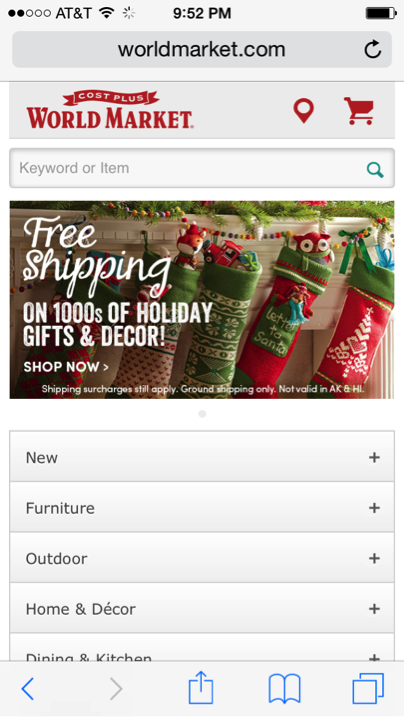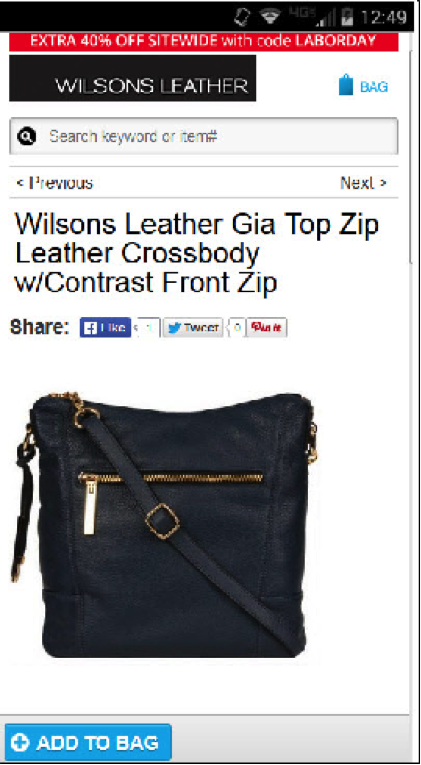By Ken Burke
With retail’s most important revenue months just weeks away, you know you need to do something now; and you can. Developing your responsive mobile site requires careful attention and keen strategy. For an increasing number of your customers, if you don’t have a fast, easy-to-use mobile site or app, you don’t exist. Mobile is now the default shopping medium, with more than 75% of online engagement with retail brands occurring on mobile devices.
There are still some some quick improvements that can yield high dividends in time for holiday shopping. Our picks include: cleaning up your code, integrating third party software tools for social media and alternative payment methods and bringing customer service front and center.
Optimize the top 20%. Even the longest most difficult ventures have a starting place. You can start your mobile journey by testing your site with Google’s convenient testing tool, called the Mobile-Friendly Test. It can diagnose any URL in about a minute, assessing in simple language whether the site meets Google’s mobile usability expectations or has some work to do.
The search engine giant also provides a list of common mistakes that hurt mobile performance, such as blocked JavaScript, CSS and image files, slow load speeds, or irrelevant cross links. Identify the issues, get them cleaned up, and your customers’ mobile experiences will improve. Shoppers won’t wait. Tests at Amazon revealed that every 100 ms increase in load time of Amazon.com decreased sales by 1%.
Identify your most popular products, categories and content and set about creating mobile-optimized versions. Make sure all landing pages, holiday promotions and sweepstakes pages are mobile-ready. The new Google algorithm assigns “mobile-friendly” status at the page level, so you can still benefit even if you adopt a piecemeal approach. Free shipping was front and center at the Cost Plus mobile site last year.
Share Buttons
Enable shoppers to syndicate your brand content everywhere. Make sure social sharing links can be easily found on all product and content pages. Social media has more influence on shoppers than current attribution models can show. Almost half of social media users report discovering new products via social media, and 36% recommend products themselves. Let those products be yours. MarketLive customer, Wilson’s Leather is a good example with sharing buttons prominently located on the top of the page just under the product title.
Piggyback on Mobile Friendly Sites for Visibility
Nearly 60% of social media time is spent not on desktop computers but on smartphones and tablets. Be sure your editorial calendar has plans in place for fresh and relevant content. Make every post a visual post because these translate best on the small screen. Get creative with images on your social media pages to ensure every post achieves its full engagement potential. That means posting photos with recipes, sourcing illustrations for quizzes and polls, and translating text quotes into images that can easily be re-pinned or reposted.
Don’t be afraid of video. Consumers spend a large amount of time watching YouTube on their phones. Google says, “On mobile, the average [YouTube] session is now over 40 minutes.” Develop video content and adapt it for native social formats. Don’t have the resources to rev up your in-house video production studio? Invite and promote visual contributions from your customers. Showcasing how shoppers interpret your brand and products shows you are listening to feedback and provides a treasure trove of content.
Invest in Social Site Advertising and Marketplaces
Major players such as Facebook and eBay are mobile-optimized to the hilt, and can give merchants a leg-up in visibility as a result via a boosted investment in marketplace listings, buy buttons, search and retargeting ads. Find the right mix for your brand and dig in.
Google’s mobile search ads, Facebook ads, Twitter ads, and Pinterest products are all eligible to include the “buy” functionality – and are especially relevant for remarketing to shoppers who’ve already had a chance to review the products in question on merchant sites and now may just need a nudge to complete the purchase.
Such advertising avenues are highly customizable and trackable. Retargeting techniques that serve search and social ads to remind shoppers about products and offers they’ve considered and left behind on merchant sites are increasingly popular. Listrak found these campaigns are effective, enjoying an average conversion rate of more than 20% — five times higher than a standard promotional campaign.
Do strike the right balance between visible and annoying. Cap the frequency of ads, and be sure to stop serving ads to shoppers who go on to convert as well as to those who haven’t responded to ads within a reasonable consideration timeframe.
Make Customer Service Front and Center
Make sure your customer service contact information is easy to find and use. Be sure to include prominently return/exchange information. All phone numbers should be click-to-call enabled. The global footer is an ideal place for this information. Just ⅓ of merchants include free shipping content on the mobile site, a often a critical differentiator during the holidays. Nike.com does a good job of including a bevy of customer service information on its cart page so shoppers ready to take the plunge need not hesitate or leave the page to answer lingering questions about their future options.
Make store locations and contact info prominent.
Shoppers often visit mobile sites not because they’re interested in making an online purchase but because they’re trying to find a physical store. Store locators that use either zip codes or GPS location data are a basic but important tool for helping shoppers quickly find the location closest to them and drive retail foot traffic.
Make checkout a breeze.
Just as important as making sure mobile sites launch quickly, merchants need to vigilantly streamline their mobile checkout processes. Offer multiple alternative payment options, whose popularity continues to soar as shoppers seek ways to skip entry of credit card data and eliminate checkout steps.
 Promote which options you offer before the final phase of checkout, so shoppers know upfront their exit will be swift. HSN.com promotes the availability of Paypal from product pages by including a “checkout with Paypal” link alongside “add to cart.”
Promote which options you offer before the final phase of checkout, so shoppers know upfront their exit will be swift. HSN.com promotes the availability of Paypal from product pages by including a “checkout with Paypal” link alongside “add to cart.”
These are just a few quick but important fixes to help you enter into the holiday mobile playing field, delivered just in the nick of time, so you can start devising your mobile-readiness New Year resolutions.
About the Author:
Ken Burke is Founder and CEO of MarketLive, a leading eCommerce Software providing enabling total commerce, Ken founded the company as Multimedia Live in 1995 with only $500 in start-up money, and under his guidance it has grown into a leading Total Commerce solution provider. Inspired by strategies and business methods from the cataloging and direct marketing world, Burke masterminded the creation of the MarketLive® Intelligent Selling® System, MarketLive’s enterprise-class e-commerce application designed to optimize all selling opportunities, build solid relationships with customers, and give merchants complete control over their online merchandising. A recognized e-commerce industry pioneer and visionary, Ken hosts frequent thought leadership events and is often quoted in Internet Retailer and other industry publications. A dynamic and popular speaker, he is a regular contributor at retail and direct marketing events. Ken is also the author of the book Intelligent Selling®: The Art & Science of Selling Online. He studied multimedia and the Internet at the University of Southern California, where he completed a BA in Marketing and earned honors as an MBA graduate in Venture Management and Entrepreneurship. For more information about MarketLive, please visit: www.marketlive.com and for more great content from Ken, please visit the MarketLive Blog- www.marketlive-blog.com. You can also follow him on Twitter or visit MarketLive on Facebook.







Recent Comments